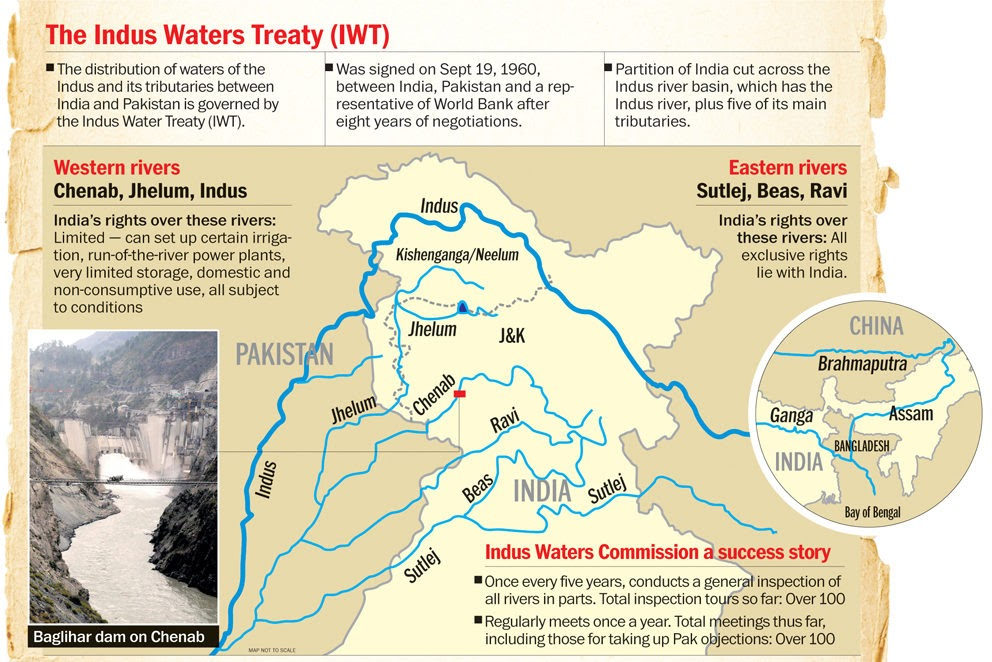Indus River system
|
River |
Source Lake |
Length (km) |
Tributaries (Left) |
Tributaries (Right) |
Valley/ Location |
Drains Into |
Major Dams |
|
Indus |
Lake Mansarovar, Bokhar Chu ‘Singi Khamban; or Lion’s mouth. |
2,880 km (Only 709 km is in India). |
Zanskar, Suru, Shyok |
Panjnad, Kabul, Khurram, the Tochi, the Gomal, the Viboa and the Sangar. They all originate in the |
Chenab |
Arabian Sea |
Tarbela, Chashma |
|
Jhelum |
Verinag Spring, Kashmir, at the foot of the Pir Panjal |
725 |
Lidder, Sind |
None |
It flows through Srinagar and the Wular lake |
Chenab |
Mangla, Uri. |
|
Chenab |
Baralacha Pass, Himachal Pradesh. Chandra and the Bhaga, which join at Tandi near Keylong in Himachal Pradesh. |
1180 |
Neeru, Tawi |
Jhelum, Ravi |
Indus |
Baglihar, Salal |
|
|
Beas |
Beas Kund, Himachal Pradesh |
470 |
Binwa, Luni |
Uhl |
Flows through the Kullu valley and forms gorges at Kati and Largi in the Dhaoladhar range. |
Sutlej near Harike. |
Pong, Pandoh. |
|
Ravi |
Kullu Hills, Himachal Pradesh |
720 |
Seul |
Ujh, Siawa |
Chamba Valley |
Chenab near Sasai sidhu |
Ranjit Sagar, Chamera |
|
Sutlej |
Lake Rakshastal, Tibet or Langchen Khambab. |
1,450 |
Spiti, Nogli |
Beas |
Shipki La on the Himalayan ranges and enters the Punjab plains. It is an antecedent river. It is a very important tributary as it feeds the canal system of the Bhakra Nangal project. |
Chenab |
Bhakra, Karcham Wangtoo |
Indus Water Treaty
Indus Waters Treaty was signed on September 19, 1960, between India and Pakistan and was brokered by the World Bank.
The treaty sets out a mechanism for cooperation and information exchange between the two sides on the use of the water of the Indus River and its five tributaries Sutlej, Beas, Ravi, Jhelum, and Chenab.
Key Provisions:
Water Sharing:
It prescribes how water from the six rivers of the Indus River System would be shared between India and Pakistan.
It allocated the three western rivers Indus, Chenab and Jhelum to Pakistan for unrestricted use, barring certain non-consumptive, agricultural and domestic uses by India and the three Eastern rivers Ravi, Beas and Sutlej were allocated to India for unrestricted usage.
This means that 80% of the share of water went to Pakistan while leaving the rest 20% of water for use by India.
Permanent Indus Commission:
Under the Indus Waters Treaty, both countries must set up a Permanent Indus Commission, mandated to meet annually.
Dispute Resolution Mechanism:
-
The IWT provides a three-step dispute resolution mechanism under which “questions” on both sides can be resolved at the Permanent Commission, or can also be taken up at the inter-government level.
-
Unresolved differences between the countries on water-sharing can be addressed by the World Bank-appointed Neutral Expert (NE).
-
Appeal from a Neutral Expert of WB can be referred to a Court of Arbitration set up by the World Bank.
Various Projects to be Inspected Under IWT:
-
Pakal Dul and Lower Kalnai: Pakal Dul Hydro Electric Project built on river Marusudar, a tributary of the Chenab. Lower Kalnai is developed on the Chenab.
-
Kishanganga Hydroelectric Project: It is a run-of-the-river project located in J&K.
-
Pakistan objected to the project arguing that it would affect the flow of the Kishanganga River (called the Neelum River in Pakistan).
-
In 2013, The Hague’s Permanent Court of Arbitration (CoA) ruled that India could divert all the water with certain conditions.
-
Ratle Hydroelectric Project: It is a run-of-the-river hydroelectric power station on the Chenab River, in J&K.

What's Your Reaction?

















